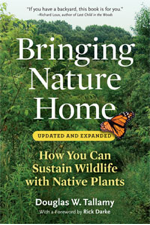Tip of the Week: Bringing Nature Home
Posted in Gardening Tips on October 18 2010, by Sonia Uyterhoeven
 |
Sonia Uyterhoeven is Gardener for Public Education. Join her each weekend for home gardening demonstrations on a variety of topics in the Home Gardening Center. |
 The lovely title of Douglas Tallamy’s acclaimed book Bringing Nature Home implies that as gardeners and environmentally minded citizens, one of our directives is to invite nature—birds, bees, butterflies, and other critters—into our landscapes.
The lovely title of Douglas Tallamy’s acclaimed book Bringing Nature Home implies that as gardeners and environmentally minded citizens, one of our directives is to invite nature—birds, bees, butterflies, and other critters—into our landscapes.
As I wrote about in the past few weeks, invasive plants change face of our natural landscape, and so do pollution and urban sprawl. In his book, an outstanding homage to biodiversity, Tallamy looks at two other destructive forces: habitat destruction and the loss of species.
Biodiversity is synonymous with a balanced ecological community. Plants, insects, and other animals have all co-evolved in communities with complex, interconnected lives that are dependent on one another.
Many insects are specialists, meaning that they feed on specific plants. This is nature’s way of ensuring that species are not decimated by predators. How do plants do this?
One way plants protect themselves is through their leaf chemistry. Different leaf compounds give plants a distinctive taste, digestibility, and toxicity. Insects have evolved so that they can break down certain compounds (i.e. eat some plants) while they are unable to digest others. Essentially, this ensures there is enough to go around.
The cycle continues—some insects feed on plants, other insects feed on insects that feed on plants, and birds feed on insects. Balanced ecosystems function on a high level and are more resilient or less susceptible to attack from diseases, pests, and invasive intruders.
The system has a certain amount of give to it. Extinction has always been a part of the natural cycle: a species may be out-competed by another or lack the resources to sustain itself. In general, however, each species colonizes its own niche and through co-evolution is able to fit together with other species like pieces in a puzzle. What happens when that balance is disrupted? We’ll take a look at this next week.

